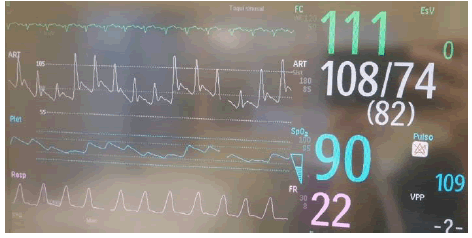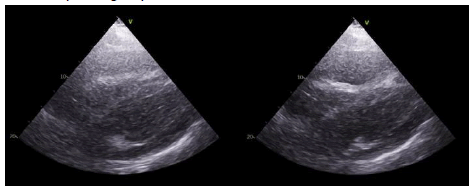Case Report - (2023) Volume 9, Issue 2
Cardiac Tamponade: Look for Pulsus Paradoxus in the Arterial Line
Monica Palma Anselmo* and
Lisete Rolo Nunes
Department of Intensive Care Unit, Hospital Fernando Fonseca, Portugal
*Correspondence:
Monica Palma Anselmo,
Department of Intensive Care Unit, Hospital Fernando Fonseca,
Portugal,
Email:
Received: 01-Mar-2023, Manuscript No. IPJICC-23-15809;
Editor assigned: 03-Mar-2023, Pre QC No. IPJICC-23-15809 (PQ);
Reviewed: 17-Mar-2023, QC No. IPJICC-23-15809;
Revised: 22-Mar-2023, Manuscript No. IPJICC-23-15809 (R);
Published:
29-Mar-2023, DOI: 10.35248/2471-8505.23.09.016
Abstract
Cardiac tamponade is a life-threatening condition with a myriad of etiologies. The diagnosis is challenging and when
left undiagnosed and untreated this results in a significant mortality. We present a case of a sixty-nine-year-old male
with a history of stage IV breast cancer that was hospitalized with a recurrent right-side pleural effusion. A thoracocentesis
was performed, and the drain removed five days after. As a complication he had extensive subcutaneous
emphysema. On the day of the ICU admission, he became obnubilated, with worsening of hypoxemia, hypotensive
and anuric. High flow nasal cannula and norepinephrine were started. A right-side chest drain was inserted. Despite
the slight improvement in oxygenation, the patient remained in shock. The arterial line showed pulsus paradoxus
leading to the suspicion of cardiac tamponade. The exuberant emphysema made the acoustic window very poor but
a huge pericardial effusion with heart swing and collapse of right cavities confirmed the diagnosis. A pericardiocentesis
was performed with the resolution of shock. This case highlights the importance of reading and interpreting
the invasive arterial line curve in the differential diagnosis of shock patients, particularly in those with poor echocardiogram
acoustic window.
Keywords
Cardiac tamponade; Pulsus paradoxus; Arterial line; ICU; Thoracocentesis; Pericardiocentesis
Introduction
Cardiac tamponade is a life-threatening condition that results from an accumulation of fluid in the pericardial space that leads to impairment of the diastolic filling of the ventricles with a reduction of cardiac output and obstructive shock [1]. The main causes of cardiac tamponade are malignancies, infectious/inflammatory, trauma, iatrogenic and post-myocardial infarction and aortic dissection [2]. Clinical presentation depends on the rate of fluid accumulation relative to pericardial compliance. The classic clinical signs are Beck´s triad, namely hypotension, distended jugular veins, and muffled heart sounds. However, this triad is present in a minority of cases. Other findings that can lead us to this diagnosis are the presence of pulsus paradoxus and electrocardiogram with low voltage QRS and electrical alternans. Pulsus paradoxus was first described by Kussmaul in 1873 in patients with cardiac tamponade and despite the
fact that it may be associated with different aetiologies, this remains one major to consider. Although cardiac tamponade is a clinical diagnosis, the echocardiography plays an important role in evaluation and guided treatment [3]. If left undiagnosed or untreated this condition is associated with significant mortality.
Case Presentation
We present a case of a 69 years old male patient that was admitted
to the Intensive Care Unit (ICU) in shock. He had a previous
history of stage IV breast cancer with pleural and bone
metastasis, ischemic cardiomyopathy with reduced ejection fraction and complete AV block with a pacemaker dual chamber.
He was hospitalized 7 days previous to the admission in the
ICU with worsening of dyspnea, ortopnea and cough. A diagnosis
of a recurrent right side pleural effusion was made and a thoracocentesis
was performed removing 920 mL of a malignant
exudate. The drain was removed 5 days after. As a complication
he had an extensive subcutaneous emphysema in the trunk,
face and upper limbs with a controlled chest X-ray revealing hydropneumothorax.
On the day of the ICU admission, he became
obnubilated, with worsening of hypoxemia, hypotensive, with
poor skin perfusion signs and anuric. Arterial blood gas with
non-rebreather mask revealed pH 7.24, pCO2 23.1 mmHg, pO2 70.2 mm Hg, HCO3 9.6 mmol/L, lactate 6.03 mmol/L. The patient
went to the CT-scan and was admitted to the ICU (Figure
1). He started high flow nasal cannula and norepinephrine at
a maximum dose of 0.63 mcg/kg/min. A right side chest drain
was inserted. Despite the slight improvement in oxygenation,
the patient remained in shock. The arterial line showed pulsus
paradoxus has exhibited in Figure 2 leading to the suspicion
of cardiac tamponade. The exuberant emphysema made the
acoustic window very poor but a huge pericardial effusion with
heart swing and collapse of right cavities confirmed the diagnosis
(Figure 3). A pericardiocentesis was performed, draining 850
ml of serous hematic fluid, with the resolution of shock.

Figure 1: CT-scan showing extensive subcutaneous emphysema and right hydropneumothorax.

Figure 2: The arterial line showing pulsus paradoxus with blood pres- sure drop during inspiration.

Figure 3: Transthoracic echocardiogram showing pericardial effusion with collapse of right cavities.
Results and Discussion
We present a case of a patient with clinical signs of shock and
a pneumothorax as an identified cause of obstructive shock. Although
the pneumothorax was drained, the patient remained
in shock suggesting another underlying cause. The arterial line
analysis revealed the presence of pulsus paradoxus. Pulsus paradoxus
in the arterial line curve can be identified as a fall of systolic
blood pressure of more than 10 mm Hg during inspiratory
phase, as demonstrated in Figure 2, with simultaneously representation
of the respiratory curve from pulse oximetry [4,5]. In
this particular case, the patient presented a limitation for the
echocardiography evaluation with extensive subcutaneous emphysema,
highlighting the value of the arterial line interpretation
in such cases.
Several mechanisms explain the pathophysiology leading to
pulsus paradoxus in cardiac tamponade. One of most importance
is ventricular interdependence. The right ventricular wall
becomes unable to fill with blood during inspiration restricted
by increased pericardial pressure and so exerting pressure in interventricular
wall. As the pericardial space is a noncompliant
space in order to the right ventricle to expand more in inspiration,
the left ventricle has to fill less resulting in a lower stroke
volume and a lower systolic pressure [5]. Another important
mechanism is the variation in left ventricular pressure with
ventilation acknowledging the negative intrathoracic pressure
during inspiration.
It is also important to emphasize that pulsus paradoxus may be
present in pericardial and non-pericardial aetiologies, as in our
patient (cardiac tamponade and pneumothorax). One should
consider the pericardial disease when the drop is mainly in systolic
pressure with a narrower pulse pressure, in contrary to
non-pericardial disease, where there is a drop in both systolic
and diastolic pressures.
Conclusion
This case has a teaching message and aims to stress the importance
of reading and interpreting the invasive arterial line
curve in the differential diagnosis of shock patients, particularly
in those with poor echocardiogram acoustic window.
Acknowledgement
None.
Conflict of Interest
The author declares there is no conflict of interest in publishing this article.
References
- Imazio M, De Ferrari GM (2020) Cardiac tamponade: An educational review. Eur Heart J Acute Cardiovasc Care 10: 102-109.
[Crossref] [Google Scholar] [Pubmed]
- Jensen JK, Poulsen SH, Mølgaard H (2017) Cardiac tamponade: A clinical challenge. ESC 15(17).
[Google Scholar]
- Alerhand S, Adrian RJ, Long B, Avila J (2022) Pericardial tamponade: A comprehensive emergency medicine and echocardiography review. Am J Emerg Med 58: 159-174.
[Crossref] [Google Scholar] [Pubmed]
- Hamzaoui O, Monnet X, Teboul JL (2013) Pulsus paradoxus. Eur Respir J 42(6): 1696-1705.
[Crossref] [Google Scholar] [Pubmed]
- Van Dam MN, Fitzgerald BM (2022) Pulsus paradoxus. StatPearls
[Google Scholar] [Pubmed]
Citation: Anselmo MP, Nunes LR (2023) Cardiac Tamponade: Look for Pulsus Paradoxus in the Arterial Line. J Intensive Crit Care. 9:016.
Copyright: © 2023 Anselmo MP, et al. This is an open-access article distributed under the terms of the Creative Commons Attribution License, which permits unrestricted use, distribution, and reproduction in any medium, provided the original author and source are credited.




